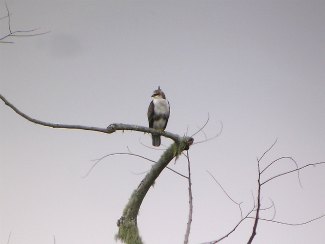Rufous-Bellied Eagle - Lophotriorchis kienerii
By Magalhães, Public Domain, via Wikimedia Commons
Family: Accipitridae
Genus: Lophotriorchis
Species: L. kienerii
Subspecies: L. k. formosus, L. k. kienerii
Rufous-Bellied Eagles are small to medium-sized raptors that live in southern Asia. As their name would indicate, they have heavy rufous coloring along the chest and belly.
Physical Description:
Rufous-Bellied Eagles are black from above and have a short but visible crest. They have a black hood and a white to rufous throat and chest; the belly and legs are rufous and streaked black. The square tail is brown and the undertail is barred with black and white. Wings are also barred, with the primary feathers white at the base. The eyes are red-brown and the cere and feet are yellow. The legs are feathered. Subspecies H. k. formosus is smaller, has greater RSD (reverse sexual dimorphism: where the female is larger than the male), and has blacker plumage than the nominate subspecies L. k. kienerii.
Juveniles are dark brown from above with a brown crown and nape, and two black eye patches. The underside is white and the tail is gray with narrow dark barring and a white tip. Eyes are brown.
Their call is a rapid series of sharp whistles. They are silent except during the breeding season. Listen to a Rufous-Bellied Eagle.
Size:
Length: 46-61 cm
Wingspan: 105-140 cm
Weight: 732 g
Habitat and Distribution:
They have been found in evergreen, deciduous, mixed, and disturbed forest, in addition to forest edges and occasionally open country. They live from 0-2,000 meters above sea level.
Rufous-Bellied Eagles occur in the Indian subcontinent and the eastern Himalayas, along with southern China and the Malay Peninsula south to the Sunda Islands and the Philippines. Their total range spans from 28°N to 9°S; adults are partial migrants. There are an estimated 1,000-10,000 individuals.
Diet and Hunting:
They eat small mammals, birds, and reptiles. Avian prey includes Eudynamys melanorhynchus (Black-Billed Koel), Lophura leucomelanos (Kalij Pheasant), kingfishers, pigeons, and poultry.
They hunt from a perch or in flight. If in flight, they will dive in the heart shape characteristic of raptors (where the wings are folded and the tips of the primary feathers are close to the tail), catching their prey in the air, on the ground, or in a tree.
By markaharper1, CC-BY-SA-2.0, via Flickr
Reproduction:
Breeding displays consist of circling and sky dances that include dives and wing-shaking. The breeding season itself is from December-March in Sri Lanka and begins in February in the Philippines.
The nest is built out of sticks, growing as large as 1.2 meters across and 60 cm deep, and placed in a tree 20-30+ meters high. One egg is laid. Incubating and nesting periods are unknown.
Conservation:
Rufous-Bellied Eagles are currently listed as Least Concern by BirdLife International, although their population is probably in decline due to habitat loss.
Taxonomy:
Lophotriorchis kienerii was formerly considered part of genus Hieraaetus, but molecular sequences of mitochondrial and nuclear genes have shown that there is no close relationship between Lophotriorchis and Hieraaetus; nor, for that matter, is Lophotriorchis closely related to any booted eagles.
Subspecies:
There are two subspecies: L. k. formosus is found in Myanmar, southern China, western, southern, and east-central Indochina, the Malay Peninsula, the Sunda Islands, and the Philippines. L. k. kienerii is found in northeastern and southwestern India, Nepal, and Sri Lanka.
Other Names:
Chestnut-Bellied Eagle, Chestnut-Bellied Hawk Eagle, Rufous-Bellied Dwarf Eagle, Rufous-Bellied Hawk Eagle, Rødbuget Høgeørn (Danish), Roodbuikdwergarend (Dutch), Nool-kääbuskotkas (Estonian), Punavatsakotka (Finnish), Aigle à ventre roux (French), Rotbauchadler (German), Elang kecil, Elang perut karat (Indonesian), Aquila minore pettocastano (Italian), Akaharakumataka (Japanese), Helang, Helang Perut Merah (Malay), Rødbukørn (Norwegian), Orzelek rdzawobrzuchy (Polish), Águila de Vientre Rojo, Aguila-azor ventrirroja (Spanish), Rödbukad dvärgörn (Swedish).
Other Multimedia:
References:
http://avibase.bsc-eoc.org/species.jsp?avibaseid=BEB2A9A892563969
BirdLife International (2012) Species factsheet: Lophotriorchis kienerii. Downloaded from http://www.birdlife.org on
12/02/2012.
Global Raptor Information Network. 2012. Species account: Rufous-bellied Eagle Lophotriorchis kienerii. Downloaded from
http://www.globalraptors.org on 12 Feb. 2012
BirdLife International 2009. Lophotriorchis kienerii. In: IUCN 2011. IUCN Red List of Threatened Species. Version 2011.2.
www.iucnredlist.org. Downloaded on 12 February 2012.
http://www.planetofbirds.com/accipitriformes-accipitridae-rufous-bellied-hawk-eagle-lophotriorchis-kienerii
Ferguson-Lees, James, and Christie, David A. Raptors of the World. Houghton Mifflin Company, 2001.

